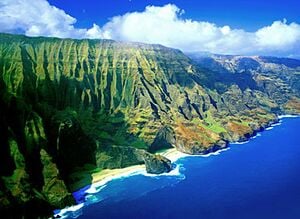
- Hawaii becomes first US state to declare a climate emergency, Apr 29, 2021...[1]
Networks and sustainability initiatives
- Hawaii Sustainable Communities Alliance, on facebook
- One Island Sustainable Living Programs, Hawaii
Community energy
Solar power
The energy sector in Hawaii has rapidly adopted solar power due to the high costs of electricity, and good solar resources, and has one of the highest per capita rates of solar power in the United States.Hawaii's imported energy costs, mostly for imported petroleum and coal, are three to four times higher than the mainland, so Hawaii has motivation to become one of the highest users of solar energy. Hawaii was the first state in the United States to reach grid parity for photovoltaics. Its tropical location provides abundant ambient energy.
Much of Hawaii's solar capacity is distributed solar panels on individual homes and businesses. Hawaii's grid has had to deal with this unique situation by developing new technology for balancing the energy flows in areas with large amounts of solar power. In 2017 distributed solar produced 913GWh which was 36% of all renewable energy produced in the state and about 9% of electricity sales. Utility-scale solar produced 212GWh, just over 1% of sales. In December 2016, Hawaii had 674MW of installed distributed solar capacity. The largest utility-scale solar farm in Hawaii is the 49 MW Kawailoa Solar project which opened in September 2019.
Wind power
Wind power in Hawaii is produced by the state's 132 commercial wind turbines, totaling 236 MW in capacity. In 2015, wind turbines produced 6.4% of Hawaii's electricity.: 2 In 2012, Hawaii generated 367 million kWh from wind power.
Coastal community activism
Sustainable Coastlines Hawaii, inspiring local communities to care for their coastlines through hands-on beach cleanups.
Arts, sport and culture
SPACE: Seaview Performing Arts Center for Education
Food activism
Hawaii Foodbank - Hawai`i SEED - Limahuli Garden and Preserve - Waipa Foundation
Sustainable transport activism
Wikipedia: Hiking trails in Hawaii (category)
Towards sustainable economies
- Island and Indigenous systems of circularity: how Hawaiʻi can inform the development of universal circular economy policy goals, ecologyandsociety.org, 2023
News and comment
2017
This Hawaiian mayor is scoring touchdowns for clean energy, Aug 8[2]
Fossil-free islands: A blueprint for sustainable development? Jun 14[3]
2015
Hawaii Just Became The First State To Ban Plastic Bags At Grocery Checkouts, July 1[4]
University of Hawaii System votes to divest from fossil fuels, May 22[5]
Hawaii Will Soon Get All Of Its Electricity From Renewable Sources, May 7
Will Hawaii be the First State to Go 100 Percent Renewable? March 16[6]
Maui runner circumnavigating the state to save the environment, February 2[7]
2014
Could small, biodiverse farms help Hawaii grow enough food to feed itself? June 19[8]
Environmental issues in Hawaii
The majority of environmental issues affecting Hawaii today are related to pressures from increasing human and animal population and urban expansion both directly on the islands as well as overseas. These include the unsustainable impacts of tourism, urbanization, implications of climate change such as sea level rise, pollution, especially marine plastic pollution, and invasive species.
About Hawaii
Hawaii ( hə-WY-ee; Hawaiian: Hawaiʻi [həˈvɐjʔi, həˈwɐjʔi]) is an island state of the United States, in the Pacific Ocean about 2,000 miles (3,200 km) southwest of the U.S. mainland. It is the only state not on the North American mainland, the only state that is an archipelago, and the only state in the tropics.
Hawaii consists of 137 volcanic islands that comprise almost the entire Hawaiian archipelago (the exception, which is outside the state, is Midway Atoll). Spanning 1,500 miles (2,400 km), the state is physiographically and ethnologically part of the Polynesian subregion of Oceania. Hawaii's ocean coastline is consequently the fourth-longest in the U.S., at about 750 miles (1,210 km). The eight main islands, from northwest to southeast, are Niʻihau, Kauaʻi, Oʻahu, Molokaʻi, Lānaʻi, Kahoʻolawe, Maui, and Hawaiʻi, after which the state is named; the latter is often called the "Big Island" or "Hawaii Island" to avoid confusion with the state or archipelago. The uninhabited Northwestern Hawaiian Islands make up most of the Papahānaumokuākea Marine National Monument, the largest protected area in the U.S. and the fourth-largest in the world.
Of the 50 U.S. states, Hawaii is the eighth-smallest in land area and the 11th-least populous; but with 1.4 million residents, it ranks 13th in population density. Two-thirds of Hawaii residents live on O'ahu, home to the state's capital and largest city, Honolulu. Hawaii is among the country's most diverse states, owing to its central location in the Pacific and over two centuries of migration. As one of only six majority-minority states, it has the only Asian American plurality, the largest Buddhist community, and largest proportion of multiracial people in the U.S. Consequently, Hawaii is a unique melting pot of North American and East Asian cultures, in addition to its indigenous Hawaiian heritage.
References